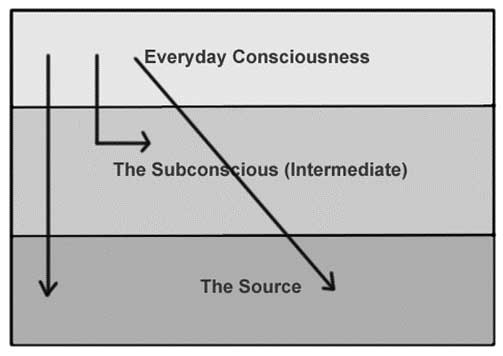In Part One of this article (Everyday Consciousness, The Realm of Power, and Source (Part One) – A Map for the Levels of the Psychospiritual Journey), we looked at a model that lays out three broad “realms” of human experience – a model which also provides something of a map for the psychospiritual journey. Shinzen Young calls these three levels Everyday Consciousness, the Subconscious (Intermediate) realm, and The Source. They might also be called Ordinary Consciousness, the Realm of Power, and the Absolute.
In the first part of this article, I gave an overview of these three levels, with some examples of what one might encounter when making contact with these different aspects of experience. In this second part, I’ll focus further on the “path through” – or the path of Awakening – and some of the ways we might either choose to explore or possibly get side-tracked into these realms.
Note – It can be fairly said that Source is neither a level nor an experience (nor is it not a level or experience!). Language and maps – naturally – distort and limit direct knowing.
The “directions” that we may take in pursuing or encountering these realms can be directly toward Source, oblique, and/or involve deliberate or accidental ninety-degree turns where we get involved in the content of the intermediate layer.
[For those who want a quick summary of this article, jump to the end here.]

Seeking the Source – Awakening/Enlightenment.
The direct line straight down to the Source is usually pursued via direct awakening practices – wherein we engage in inquiry and/or meditation as a way of cutting through the distractions of mind and experience. This direct kind of practice shows up in different psychospiritual traditions, but all tend to have in common some combination of concentration, open awareness, equanimity, and direct investigation of experience (e.g., as found in such traditions/practices as vipassana, mahamudra, dzogchen, shikantaza, advaita).
In the direct path, we orient straight to the Source and make no distinctions, seeking always to contact and recognize our lack of separation from the Unborn – the place from which all ordinary and altered states emerge and to which they return.
Many – if not most – psychospiritual traditions that are concerned with awakening, are implicitly or explicitly aiming at this layer. Within the lore of psychospiritual traditions, there are descriptions of experiences that emerge on the deep fringes of the intermediate layer that pass for awakening in the ultimate sense of that word. For example, many practitioners will take the light and sound show that is a kundalini awakening and mistake that for arrival at the Source. There are even more subtle psychospiritual experiences – such as the transpersonal Witness – that feel like they must be the Source. But most enlightenment traditions are careful to point out the dangers of getting stalled or sidetracked on the way to the Source – and that we might wish to inquire into all experiences, no matter how positive, or apparently profound.
Exploring the Intermediate Realm – Deliberately or as a Byproduct.
Young notes that, “the intermediate layer could paradoxically be described as either the realm of power or the realm of blockage.” This description holds true whether we are deliberately exploring this realm and seeking greater capacities, or whether we are passing through it on the way to the Source. We might encounter experiences in this realm because we are explicitly interested in and exploring this realm, or we might encounter this realm as a byproduct of seeking a direct route to the Source.
Some people engaged in practices directed right at the Source will still encounter the intermediate realms extensively, while others will be encounter it only minimally.
In diving directly down to the Source in our psychospiritual practice, we may or may not have experiences in the intermediate realm where we encounter our ordinary personal unconscious (i.e., I didn’t know how angry I was. I’m learning how frightened I am of authority figures.). We may also have experiences where we encounter nonordinary states (e.g., prophetic dreams), or tap collective aspects of the unconscious (e.g., having an encounter with a saint, or plant spirit).
It should be noted that what happens in the intermediate realm reflects important areas of human endeavor. What happens there is the basis for much creativity, healing, intuitive insight, and exciting narratives. This is in addition to the pain and trouble that we can run into there. That’s the human experience! It simply needs to be noted that what happens in the intermediate realms – however exciting or enticing – is often mistaken for having arrived at the Source (notwithstanding that ultimately all states and experiences arise and fall “within” this Source). Additionally, we should know that troubling experiences we encounter (e.g., painful memories, emotions, imaginings) in passing through the Intermediate Realms needn’t mean we’re “doing it wrong.”
Exploring the Intermediate Realm – The Ordinary Unconscious.
Sometimes we might dive down into the unconscious and explore it at “ordinary” levels for various purposes. Traditional psychotherapies, coaching, and self-development practices support us in this exploration by helping us become aware of unconscious blocks and resources available within our “personal” unconscious. We might strive to discover limiting beliefs, old traumas and baggage, and do some housecleaning. We might also seek to empower ourselves aby implanting or re-scripting certain beliefs/attitudes about ourselves and the world.
On the psychospiritual path, the intermediate realms may be important to attend to in those cases where – in pursuit of the Source – we find that our inner or outer life does not support being able to practice our Practice. We may have trauma or other painful material in our history, or have a life and environment that are perhaps too chaotic to support our psychospiritual pursuits. For example, when we sit to meditate, we might be periodically overwhelmed by painful memories and inner stories. Or our life might be filled with interpersonal conflict in a way that doesn’t all us to “settle” enough to be able to practice Presence. In these cases, it can make sense to do whatever psychological work is needed to help us create a more stable inner/outer environment so we can do our Practice.
Remember, even if we are orienting directly to the Source, we still might encounter aspects of the ordinary unconscious “on the way” to Source.
Exploring the Intermediate Realm – The Nonordinary Unconscious.
Sometimes we might be interested in deliberately exploring nonordinary phenomena and states (e.g., lucid dreaming, shamanic journeying, remote viewing, mediumship, encounters with archetypes, shamanic practices). Some schools of psychotherapy operate in this realm (Jungian psychotherapy, psychosynthesis, process work) and have tools and practices for engaging it. This realm is a legitimate realm of inquiry and exploration, and an area to be further explored in human experience.
As noted earlier, even if we are orienting directly to the Source in our psychospiritual practice, we might still encounter the nonordinary unconscious on the way. An example would be that during meditation, we start having experiences where we see lights, experience energy movement, find ourself outside of our body, see through closed eyes, and so forth. This is not inherently a problem; it only becomes one if we forget our purpose and let it pull us in.
Nondirect Routes and Possible Distractions.
Instead of taking a plumb line straight “down” to the Source, we can dip a few steps into the intermediate realm of the Unconscious and then take a ninety-degree turn and stay in the intermediate realms. Alternatively, we can follow an oblique angle that samples aspects of the intermediate realm as we steadily “move toward” the Source.
What does it look like to dip into the realm of power and turn ninety degrees? This can happen either deliberately – because we want to explore the intermediate realm – or it can happen as a distraction – i.e., we profess that we want to awaken, but we get sidetracked into enticing experiences in the intermediate realms.
For example, in dipping into the ordinary personal unconscious, we might get immersed in endlessly unearthing and exploring the contents of our unconscious (e.g., family history, traumas, patterns, unknown attitudes). Or we may try to put our unconscious “to work” to fulfill some other unconscious program (e.g., manifest wealth, become a person of power and authority, increase our athletic or other prowess).
This ninety-degree turn could also take the form of moving “deeper” into the unconscious (e.g., into its nonordinary and/or collective components) and we become fascinated with various phenomena that are attractive and possibly exciting (e.g., channeling/mediumship, seeking kundalini experiences, out-of-body travel, energetic or paranormal phenomena).
We might have an experience and think, “Yes, but, surely this (light, insight, expansiveness) is IT, right?” And then we’re off on a chase to maintain, recover, or have more of that experience. Alternatively, we might feel, “Oh, but certainly we’re trying to have less of this (resistance, dullness, anger, ego, selfish thoughts, etc.) because that would mean we’re more awakened, right?” These are all forms of grasping that can sidetrack us from dropping straight down to the Source.
One of the dangers in any spiritual path is spiritual bypass – believing we’re spiritually evolved in a way that allows us to side step responsibility for our own psychological blind spots (e.g., narcissism, dissociation, intellectualization). Nonordinary experiences (e.g., lights, energetic movements, witness states) in the Realms of Power may particularly encourage us to feel enlightened in ways that help us deny unconscious blind spots.
Remember, the Source is the source of all that arises, both ordinary and nonordinary. Every experience – at its root – reveals Source because it is Source. If we know we’re having an experience, it bears inquiring into it.
The Three Realms and the Path – A Summary
To quickly summarize, there is a useful map that touches on three broad “levels” of human experience. The levels can be described as Everyday Consciousness, the Subconscious (which includes the ordinary personal unconscious as well as nonordinary aspects), and The Source.
All three levels reflect potentials for peoples’ experience, and the map can provide insight into what can happen along the way in the psychospiritual journey. The paths into and through the layers can be (1) directly aimed at Source, (2) obliquely aimed at Source (while collecting experiences and capacities along the way), and can (3) dip down into the Intermediate realms and turn ninety-degrees – either deliberately or accidentally. Thus, this intermediate realm can be a destination or distraction, depending on our purposes. Aiming toward Source, we may still encounter experiences in the personal and/or collective unconscious. We may also find that we need to address unconscious psychological concerns in order to fully commit to our psychospiritual practice.
Enlightenment practices (whether direct or gradual path practices) are aimed at the Absolute – the Ground of Being. Tapping this level – or realizing our identity with it – is often called things like Awakening, or discovering our True Nature. When we touch this Source, distinctions about what is personal/nonpersonal/transpersonal, ordinary/nonordinary, or conscious/unconscious may suddenly seem unnecessarily restrictive. We may register that the personal is the transpersonal, and what we’d consciously imagined ourselves to be as individuals is – and always was – just a fiction of our imagination.
If the intersection of psychological work and awakening practice interests you, or if you are encountering some of these highways and byways in your psychospiritual practice – and need support in sorting out what is happening, please contact me!

